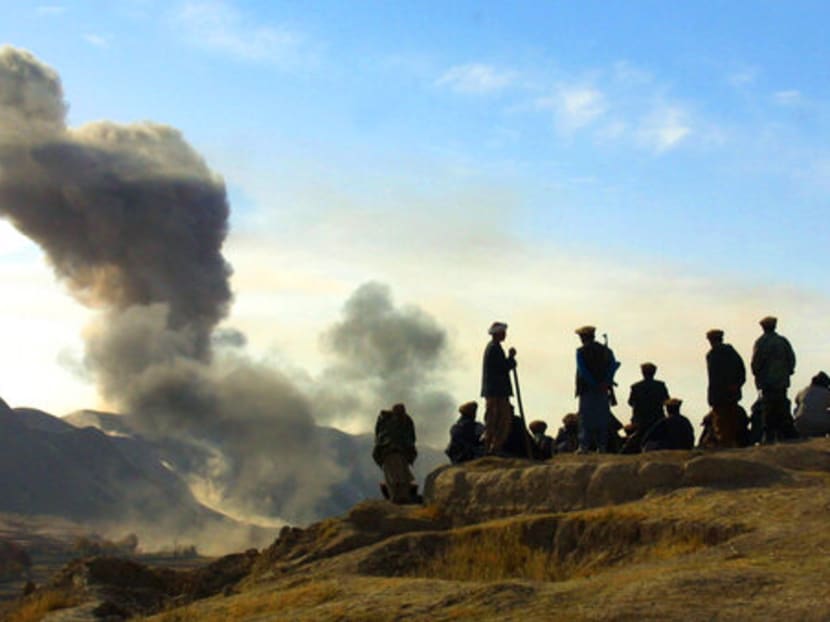Commentary: India’s Taliban problem is really about China and Pakistan
Beyond the Taliban regime to its northwest, India grapples with a nuclear-armed, terrorism-supporting state to its west and a rival superpower to its northeast, says Shashi Tharoor.

NEW DELHI: In the weeks since the Taliban’s theocratic terrorists returned to power in Kabul, the people of Afghanistan, particularly its women and girls, have been subjected to unimaginable suffering as the world’s attention turns to other issues.
But many other countries, and especially India, have reason to worry.
The Taliban’s victory, following 20 years of unsuccessful American-led “nation-building” efforts in Afghanistan, will not only greatly embolden their fellow militants, but will also shake up the region’s geopolitics.
For evidence of the destabilising impact of Kabul’s fall, just look at the reactions of Afghanistan’s neighbours.
Pakistani Prime Minister Imran Khan’s response – notably his statement that the Taliban’s return to power was akin to throwing off “the shackles of slavery” – highlights what was already known: Taliban-run Afghanistan will be a creature of Pakistan.
When the Taliban ruled the country from 1996 to 2001, their “Islamic Emirate” functioned as a wholly owned subsidiary of Pakistan’s Inter-Services Intelligence (ISI) agency.
This time, Pakistan’s control is supposedly a little less absolute, but that did not prevent ISI chief Faiz Hameed from travelling to Kabul soon after its fall to preside triumphantly over the formation of the new Taliban government.
OVERTURES FROM BEIJING
Less overtly but arguably more importantly, China has been working to make the best of a delicate situation.
The Chinese have invested US$62 billion in the China-Pakistan Economic Corridor (CPEC), the single largest project of its transnational Belt and Road Initiative, and are anxious that Taliban extremists do not jeopardise it. Significantly, Foreign Minister Wang Yi formally received a Taliban delegation in July.
With economic and strategic gains ripe for the taking, China has announced that it will do business with the Taliban. It is seeking to tap Afghanistan’s considerable underexploited mineral resources, especially rare earths, and reopen the Mes Aynak copper mine.
There is even talk of extending the CPEC to Afghanistan.
The warm overtures appear to be mutual, with Mullah Abdul Ghani Baradar, Afghanistan’s new first deputy prime minister, calling China a “trustworthy friend”, despite its systematic persecution of its own minority Muslim population.
China’s priority vis-a-vis Afghanistan is to ensure that the Taliban offer neither support nor refuge to Uyghur dissidents from Xinjiang and do nothing to disturb the functioning of the CPEC.
With the Taliban government desperately in need of patronage – 80 per cent of the previous Afghan government’s US$5.5 billion budget was financed by external assistance – China seems ideally suited to fill the breach.
AFGHANISTAN-PAKISTAN-CHINA AXIS A RISK FOR INDIA
These regional dynamics, with Pakistan and China becoming increasingly close, should be of enormous concern to Indian policymakers.
Pakistan is a long-term adversary that has actively funded and fomented armed militancy against India, hosting (among others) the organisers of the murderous 2008 Mumbai terror attacks.
China, meanwhile, is a systemic rival to India and poses economic, military, and strategic threats. Any Afghanistan-Pakistan-China axis involving policy coordination is a major risk for India.
The Taliban’s takeover of Afghanistan gives Pakistan not only the “strategic depth” its military has long sought against India, but also a useful recruiting ground for more militants and terrorists, should the ISI seek to deploy them again.
The last time the Taliban were in power, India made common cause with Russia and Iran in actively supporting the Panjshir Valley insurgency of the Northern Alliance under the late Ahmad Shah Massoud.
This time, however, an increasingly pro-Chinese Russia has taken a neutral stance on Afghanistan’s issues with India.
Iran, under its recently elected hardline president, Ebrahim Raisi, seems willing to accept the new Islamic emirate as long as the Taliban refrain from the anti-Shia persecution that characterised their previous reign.
If Afghanistan’s Shia Hazaras and culturally Persian-influenced Tajiks and Uzbeks are saved the worst of what the Taliban inflicted upon them a quarter-century ago, Iran may stay neutral.
Both Iran and Russia are, in any case, pleased that the United States has received its comeuppance in Afghanistan.
INDIAN DIPLOMATS IN TOUCH WITH TALIBAN
India could try to reach out to the new government in Kabul, despite recently denying that its external affairs minister met with Taliban representatives in Doha in June.
Other Indian diplomats certainly were in touch with Taliban officials, two of whom – Baradar and Sher Mohammad Abbas Stanikzai, the deputy foreign minister – are in the new Afghan government.
Baradar spent eight years in Pakistani detention and may be presumed to have no great love for his jailers. But while some Taliban officials have spoken soothingly of wanting good relations with India, others have stated that their Islamic emirate will stand up for India’s Muslims, especially in Kashmir.
Pakistan cannot afford to be complacent about the Taliban’s victory. The emergence of the Tehreek-e-Taliban Pakistan, which seeks to overthrow the Pakistani government for being insufficiently Islamist, and of the Islamic State-Khorasan, which bombed Kabul airport in August, should be triggering anxiety in Islamabad.
Moreover, the end of the US troop presence in Afghanistan reduces America’s logistical dependence on the Pakistani security establishment, depriving the ISI of support and resources.
India has invested US$3 billion in Afghanistan – in dams, highways, electricity grids, hospitals, schools, and even the parliament building. With all this now in Taliban hands, Indian policymakers may be forgiven for feeling despondent.
And Prime Minister Narendra Modi’s government has done itself no favours with its consistently anti-Muslim rhetoric and domestic policies, which are likely to stoke resentment across the Islamic world.
The Quad partnership – comprising India, the US, Japan, and Australia – strengthens India’s maritime presence in the Indian Ocean. But the main security threats to the country are on its land borders with China and Pakistan, where the Quad is unlikely to be of much use.
India now has a Taliban regime to its northwest, a nuclear-armed, terrorism-supporting state to its west, and a hostile superpower to its northeast, and it faces ongoing threats to its territorial integrity.
In this environment, maintaining national security and regional stability will pose an unprecedented challenge for Indian diplomacy in the months and years ahead.
Shashi Tharoor, a former UN under-secretary-general and former Indian Minister of State for External Affairs and Minister of State for Human Resource Development, is an MP for the Indian National Congress. PROJECT SYNDICATE











